Is it dangerous to eat pumpkin with pancreatitis?
Pancreatitis is an acute and chronic inflammation of the pancreas. The danger of the disease lies in the high likelihood of developing complications, such as necrosis of the gland areas and abscesses. A favorable prognosis is given by timely started therapy and adherence to the diet. For the gastrointestinal tract, in particular the pancreas, pumpkin is useful.
This vegetable normalizes intestinal acidity, has a mild laxative effect, inhibits inflammation, is a good antioxidant and a source of a large amount of vitamins, micro- and macroelements that are beneficial for the body. Let's figure out whether it is possible to eat pumpkin with pancreatitis and cholecystitis or not, in what form it is better to use it.
The content of the article
Is it possible to eat pumpkin with pancreatitis in acute and chronic form
In acute pancreatitis, in order to reduce activity and ensure functional rest of the pancreas, therapeutic fasting is prescribed for 2 to 16 days.
As the general condition improves, the diet includes foods that do not load the pancreas: grated viscous cereals, vegetable purees, vegetable and cereal soups, dietary meat, low-fat fish. Pumpkin is introduced into the diet 4-5 days after the attack at the same time as potatoes, zucchini, carrots.
The product is well absorbed by the body, does not cause severity and discomfort during digestion in the duodenum. In addition, pumpkin has an alkalizing effect: it reduces the content of hydrochloric acid in the stomach, enhances the production of pancreatic juice, under the influence of which the breakdown of proteins, fats and carbohydrates occurs.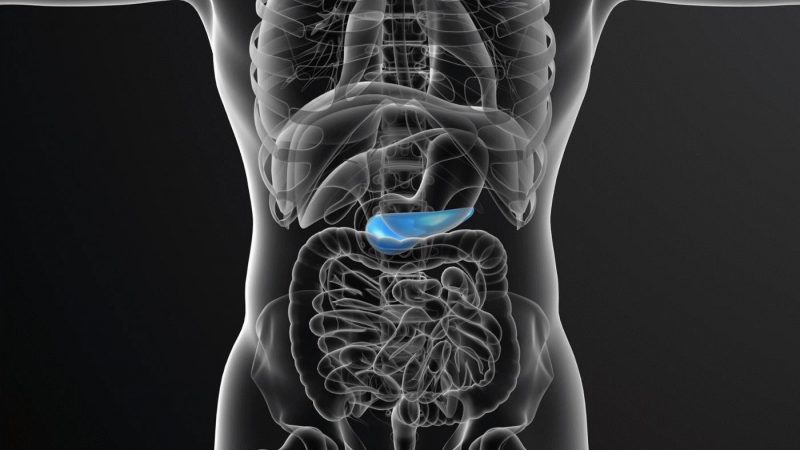
In chronic pancreatitis and cholecystitis, pumpkin is consumed in remission after symptoms subside.
Important! Pumpkin pulp and pumpkin juice are contraindicated in case of individual intolerance to the components, low-acid gastritis, diabetes mellitus, during an exacerbation of gastrointestinal diseases, the formation of large stones in the gallbladder and bile ducts.
Useful properties of a vegetable
The pumpkin contains a large amount of vitamins, micro- and macroelements, fiber, protein, pectin substances, nicotinic and ascorbic acid. Pumpkin satisfies the body's needs for silicon, cobalt, copper, calcium, potassium, zinc, and iron.
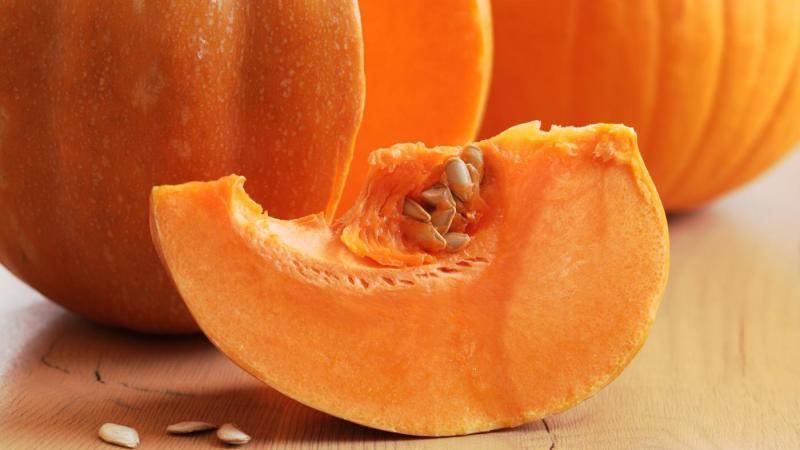
The benefits of pumpkin is as follows:
- has a choleretic effect, which helps to get rid of edema;
- improves the condition of the walls of blood vessels, increases their elasticity;
- stabilizes blood pressure in hypertension;
- removes toxins and toxins from the body, cleans the liver;
- due to the diuretic action, it clears the gallbladder;
- slows down the aging process;
- prevents the growth of cancer cells;
- participates in the formation of new cells;
- accelerates the regeneration of the epithelium;
- strengthens teeth and bones;
- prevents the development of cardiovascular disorders;
- neutralizes free radicals;
- normalizes metabolism;
- favorably affects the condition of the skin, hair, nails;
- reduces the production of stress hormones, improves mood in people prone to depression;
- promotes weight loss;
- lowers cholesterol levels.
Treatment with pumpkin of the pancreas can reduce the severity of symptoms, shorten the recovery time, and increase the protection of mucous membranes.Pumpkin improves intestinal peristalsis, evens out the acid-base balance, reduces the content of hydrochloric acid in the stomach, and activates the production of pancreatic juice.
Read also:
How to use dill seeds for pancreatitis and how they are useful.
What form is better to eat pumpkin
In the acute period of pancreatitis, it is recommended to use exclusively boiled pumpkin - so it is easier to digest and digest. The pulp should be well-boiled, tender, without peel and seeds, with a uniform consistency. To do this, use a blender, mixer or grind through a sieve. Sugar, salt, cream, sour cream and other spices, spices, prohibited vegetables and fruits are not added to the dish. Pumpkin is consumed warm, as too cold or hot food can aggravate the patient's condition.
During a period of stable remission, the number of pumpkin recipes increases, making the diet tasty and varied. The pulp of the fruit is not only boiled, but also baked, stewed, steamed, processed into juice. To improve the taste of pumpkin, it is allowed to add skim cream, milk, sugar, salt, butter to it.
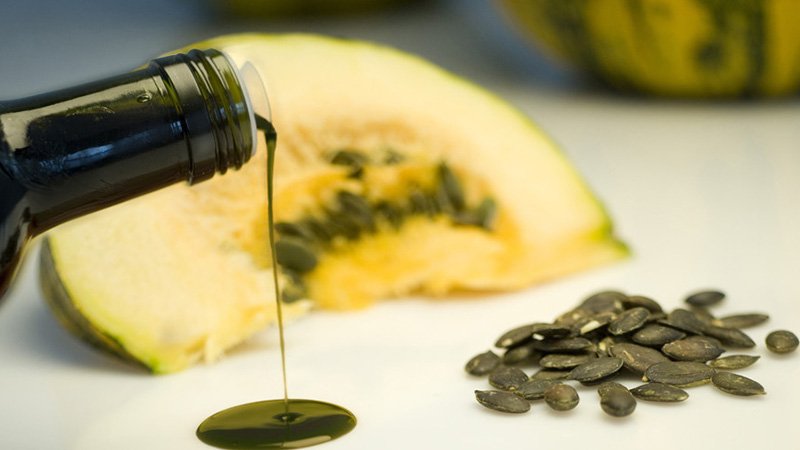
Important... Raw vegetables are undesirable even in the remission stage of chronic pancreatitis and cholecystitis, as it is too heavy for the stomach. A limited amount of fresh pumpkin can be consumed no earlier than three months after the symptoms have completely disappeared.
Pumpkin juice include in the diet during a period of stable remission. It can do more harm than good as it contains organic acids and ballast substances that stimulate increased flatulence and diarrhea. In the absence of contraindications, an adult is allowed 200-400 ml of pumpkin juice per day, no more than 2-3 times a week.
Pumpkin recipes for pancreatitis: delicious and healthy dishes
A large number of dietary meals can be prepared from pumpkin. Casserole, salad, porridge, pancakes, cream soup, mousse, candied fruit, stew, jelly, baked goods - all this is allowed during the period of remission. To get the most positive effect on the digestive organs, you should not fry the pumpkin in oil or other fat, as the calorie content of the dish increases, not to mention the harmful carcinogens.
Fruit pulp is recommended to be cooked with easily digestible low-calorie foods. Pumpkin dishes are used as a full breakfast, lunch, dinner, or as a snack.
Carrot and pumpkin puree
The dish can be prepared sweet or savory. Salty goes well with cheese, vegetables, feta cheese. Serve as a side dish for lean meat.
Ingredients: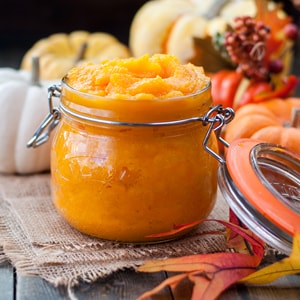
- fresh pumpkin pulp - 500 g;
- carrots - 250 g;
- water - 500 ml;
- salt and sugar to taste.
How to make carrot and pumpkin puree:
- Peel the pumpkin and carrots, remove the seeds from the pumpkin.
- Cut the pumpkin into small pieces of arbitrary shape, carrots into thin rings.
- Pour water into a saucepan with a thick bottom, add carrots. After boiling, cook for 10 minutes, leaving the lid of the pan ajar.
- After 10 minutes, add the pumpkin, stir, cook with the lid closed for about 15 minutes until tender.
- Pour the vegetable broth into another bowl. You may need it to dilute thick puree.
- Season hot vegetables with salt or sugar to taste. Beat with a blender until smooth.
The dish is served warm. Store in a refrigerator with a tightly closed lid for no more than 48 hours.
Pumpkin casserole with apple
Products: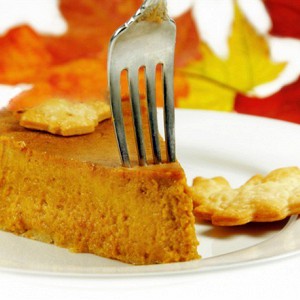
- pumpkin pulp - 0.5 kg;
- medium apples - 2 pcs.;
- eggs - 2 pcs.;
- semolina - 125 g;
- sugar - 2 tbsp. l .;
- butter - 125 g;
- vanillin on the tip of a knife;
- a whisper of salt.
Recipe:
- Wash pumpkin, peel, remove seeds. Cut into pieces and place in a pot of water. Cook covered for 15-30 minutes until tender. Cooking time may increase depending on the type of pumpkin.
- With the help of a colander, drain the water, salt the pulp, mash with a crush. Allow to cool.
- Peel the apples, grate on a coarse grater.
- Beat eggs and sugar with a mixer until thick foam.
- Put chopped pumpkin, apples in a dry container, add softened butter, vanilla, mix everything.
- Add 1/3 of the whipped proteins to the dough, distribute them evenly with a kitchen spatula. Then add the rest of the egg mass, mix gently.
- Cover the baking dish with parchment, grease with oil, lay out the dough.
- Bake in a preheated oven at 180-200⁰С for half an hour.
- Leave the finished pie to cool, then transfer to a dish.
Pumpkin casserole is good for breakfast with tea or for dinner due to its low calorie content.
Pumpkin pulp puree soup
The dish is recommended to be cooked in water or low-fat broth.
Ingredients: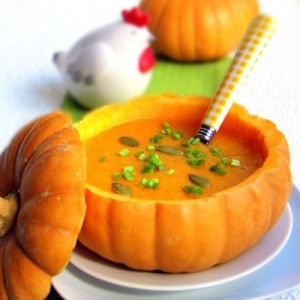
- fresh pumpkin - 400 g;
- broth (water) - 300 ml;
- carrots - 1 pc.;
- onion - 1 pc .;
- olive oil - 40 g;
- salt to taste;
- greenery.
Recipe:
- Wash and peel the vegetables, cut into small cubes, pour over the broth, add olive oil.
- Put on medium heat and simmer under the lid. Average cooking time is 30 minutes. 10-15 minutes until ready to salt.
- Cool the soup, grind with a blender in mashed potatoes.
- Add in portions finely chopped herbs, low-fat cream. Serve with crisp bread, bran bread or croutons.
With pancreatitis, it is better to eat such a soup no more than once a day, at lunchtime.
Eating pumpkin seed oil
Pumpkin seed oil used raw as a dressing for salads, vegetables, as a base for sauce. The oil is added in cereals, dishes from potatoes, lentils, beans, peas, they are seasoned with pasta.
Pumpkin seed oil emphasizes the taste of zucchini, gives an original taste to meat, fish, poultry. Also used as a flavoring additive for baked goods.
reference... Pumpkin seed oil, after heating, loses all its beneficial properties, so it is not cooked. Due to the pronounced aroma, they are added to dishes in small quantities, 2-3 drops are enough.
Rice porridge with pumpkin
In case of intolerance or poor digestibility of rice, it can be replaced with other low-calorie cereals, for example, oatmeal or millet, in extreme cases - buckwheat. The dish is prepared sweet or salty, in water or skim milk.
Products: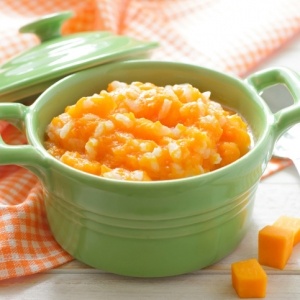
- pumpkin - 250 g;
- milk (water) - 1 l.;
- rice - ½ cup;
- apple - 1 pc.;
- honey - 1 tbsp. l.
Cooking method:
- Cut the peeled pulp into cubes, put in a saucepan, pour in milk, cook under the lid until tender. Average cooking time is 30 minutes. The finished pumpkin will be soft. Purée with a blender.
- Rinse the rice with cold water, add milk, cook until half cooked. After 30 minutes add pumpkin puree, honey and apple, grated on a coarse grater, mix.
- Turn off the fire, close the pan with a lid, leave on the stove for 15-20 minutes to infuse. Serve with candied fruits, dried fruits.
Salted pumpkin porridge is cooked in water, milk or low-fat broth. Instead of honey and apples, add a little salt, cinnamon to taste, butter.
Boiled pumpkin
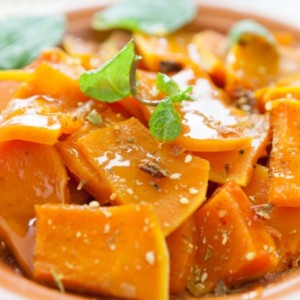
Wash the pumpkin, cut in half lengthwise, remove the seeds, peel. Cut into small cubes, about 2x2 cm, transfer to a saucepan, cover with cold distilled water.
Cook over medium heat, covered for 30 minutes (cooking time depends on the variety). Check the readiness of the pumpkin with a fork. You cannot digest the pumpkin, otherwise it will be saturated with water and turn into porridge.
Remove residual water with a colander. Before serving, sprinkle with sesame seeds, powdered sugar, season with honey.
Conclusion
Pumpkin is essential for the normal functioning of the pancreas. However eating a vegetable in the acute period, in too much or in the presence of contraindications, it can negatively affect the patient's condition, aggravate the course of the disease, provoke a new attack.With almost no restrictions, pumpkin can be eaten during remission. It strengthens the pancreas and has a beneficial effect on other important organs.
For the use of pumpkin to be as beneficial as possible, it is necessary to use the pulp of the fruit, pumpkin juice and oil for gastronomic and medicinal purposes only after consulting a doctor. The doctor will take into account the stage of the disease, the severity of the symptoms, and the patient's history.